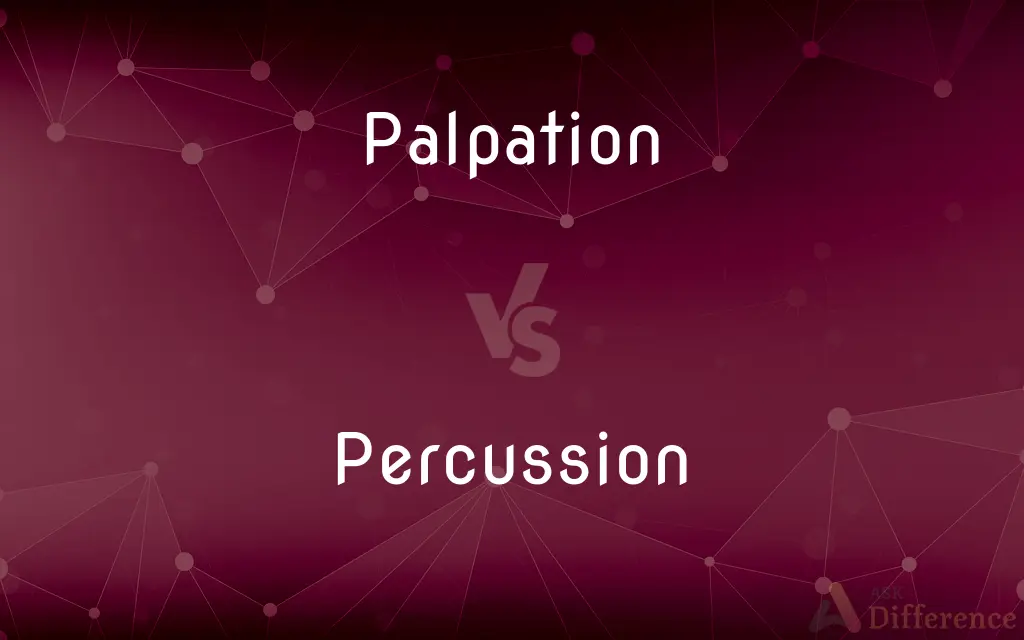Palpation vs. Percussion — What's the Difference?
Edited by Tayyaba Rehman — By Maham Liaqat — Updated on March 6, 2024
Palpation involves physical examination through touch, assessing organs and tissues. Percussion involves tapping on the body to hear sounds indicating abnormalities.

Difference Between Palpation and Percussion
Table of Contents
ADVERTISEMENT
Key Differences
Palpation is a diagnostic technique used by healthcare professionals to feel the body's various parts with their hands. Through palpation, doctors can assess the size, shape, firmness, and location of certain organs and identify any abnormalities or tenderness. Percussion, on the other hand, involves tapping on the body's surface to produce sounds that can be interpreted to understand the underlying structures. This technique helps in assessing the presence of fluid in areas where it shouldn't be, like the lungs in cases of pneumonia, or determining the size and borders of organs such as the liver and spleen.
This method of palpation is particularly useful for examining the abdomen, lymph nodes, and detecting lumps in tissues such as the thyroid gland. The sounds produced during percussion can indicate whether the underlying tissues are filled with air, fluid, or are solid.
While palpation provides direct feedback on the texture, consistency, and presence of structures or abnormalities, percussion offers insights based on the acoustic properties of body tissues. Palpation is often used as a preliminary examination method, guiding further diagnostic approaches, whereas percussion requires more specific knowledge to interpret the sounds accurately.
Both palpation and percussion are part of the physical examination process, but they serve different diagnostic purposes. Palpation is more tactile and directly engages with the patient's body, requiring sensitivity and experience to discern subtle differences in tissue feel. Percussion, while also hands-on, relies on auditory cues to inform the clinician about the state of internal organs.
In terms of training and skill, palpation can be learned and applied effectively with less specialized training compared to percussion, which requires a finer understanding of the sounds produced by different tissues. This makes palpation a more universally employed method by healthcare providers of various levels, while percussion is a skill refined with experience and practice.
ADVERTISEMENT
Comparison Chart
Definition
Examination technique involving touch to assess organs and tissues.
Diagnostic method involving tapping to produce sounds for assessment.
Purpose
Assess size, shape, consistency, and presence of abnormalities.
Determine the presence of fluids, size, and borders of organs.
Technique
Direct touch and pressure with hands.
Tapping on the body to listen to the resulting sounds.
Skills Required
Sensitivity to feel differences in tissue texture and firmness.
Ability to interpret sounds produced by different tissues.
Diagnostic Focus
Tactile feedback on physical characteristics and abnormalities.
Acoustic properties indicating air, fluid, or solid states in body areas.
Compare with Definitions
Palpation
A method for assessing the texture, size, and consistency of organs.
The palpation of her thyroid gland showed a small nodule.
Percussion
The method used to assess the size and density of organs.
Liver percussion indicated an enlarged liver.
Palpation
Hands-on examination to detect the presence of lumps or masses.
Palpation is crucial for early detection of cancerous lumps.
Percussion
Tapping on the body surface to identify fluid in cavities.
Percussion of the abdomen suggested the presence of ascites.
Palpation
A diagnostic technique using touch to examine body parts.
During palpation, the doctor detected an enlarged lymph node.
Percussion
Using sound to evaluate the presence and extent of abnormalities.
The dull sound upon percussion hinted at a pleural effusion.
Palpation
The act of feeling the body with hands to identify abnormalities.
Palpation of the abdomen revealed tenderness in the lower right quadrant.
Percussion
A technique to differentiate between solid, fluid-filled, and air-filled spaces.
Percussion sounds vary significantly between healthy and diseased lung tissue.
Palpation
Evaluating the body's surface and underlying structures through touch.
The physical exam included palpation of the patient's joints for swelling.
Percussion
A method of medical diagnosis in which various areas of the body, especially the chest, back, and abdomen, are tapped to determine by resonance the condition of internal organs.
Palpation
Palpation is the process of using one's hands to check the body, especially while perceiving/diagnosing a disease or illness. Usually performed by a health care practitioner, it is the process of feeling an object in or on the body to determine its size, shape, firmness, or location (for example, a veterinarian can feel the stomach of a pregnant animal to ensure good health and successful delivery).
Percussion
A diagnostic technique involving tapping on the body to hear sounds.
Percussion of the chest can help diagnose pneumonia.
Palpation
To examine or explore by touching (an organ or area of the body), usually as a diagnostic aid.
Percussion
The striking together of two bodies, especially when noise is produced.
Palpation
(medicine) The act of feeling or pushing on various parts of a patient’s body to determine medical condition such as the normality of organs or the presence or absence of tumors, swelling, muscle tension, etc.
Percussion
The sound, vibration, or shock caused by the striking together of two bodies.
Palpation
Act of touching or feeling.
Percussion
The act of detonating a percussion cap in a firearm.
Palpation
Examination of a patient by touch.
Percussion
The act of tapping or striking the surface of the body in order to learn the condition of the parts beneath by the sound emitted or the sensation imparted to the fingers. Percussion is said to be immediate if the blow is directly upon the body; if some interventing substance, as a pleximeter, is, used, it is called mediate.
Percussion
The act of exploding a percussion cap
Percussion
The section of a band or orchestra that plays percussion instruments
Common Curiosities
Can palpation detect fluid in the body?
While palpation can suggest the presence of fluid through swelling or tenderness, percussion is more specifically used to detect fluid in body cavities.
What is palpation?
Palpation is a diagnostic method where a healthcare provider uses touch to examine the body's parts for any abnormalities or disease.
Why is percussion important in diagnosing respiratory conditions?
Percussion helps identify abnormal lung sounds that indicate conditions like pneumonia or pleural effusion by detecting fluid or air in the lungs.
What kind of sound indicates a solid organ during percussion?
A dull sound typically indicates a solid organ or fluid-filled space, in contrast to the hollow sound associated with air-filled cavities.
Are palpation and percussion used together?
Yes, they are often used together in a physical examination to provide a more comprehensive assessment of the patient's condition.
How does the technique of palpation vary among different body parts?
The technique of palpation may vary in pressure and method depending on the body part being examined, such as gentle palpation for tender areas or deeper palpation for abdominal organs.
Is palpation used in cancer detection?
Yes, palpation is commonly used to detect lumps or masses that may indicate the presence of cancer, such as in thyroid examinations.
Can percussion be used to diagnose heart problems?
While percussion is less commonly used for direct heart assessment, it can help in evaluating the size of the heart indirectly through the detection of changes in adjacent areas.
What is percussion?
Percussion is a diagnostic technique that involves tapping on the body surface to listen to the sounds produced, aiding in assessing the underlying structures.
How do palpation and percussion differ in their diagnostic approach?
Palpation relies on the sense of touch to assess the size, consistency, and presence of abnormalities, while percussion uses sound to evaluate the condition of internal organs.
Can anyone perform palpation and percussion?
While basic palpation can be performed by most healthcare providers, effective percussion and interpretation of its findings require specific training and experience.
How does experience affect the accuracy of palpation and percussion?
Experience significantly enhances the accuracy of both palpation and percussion, as practitioners develop a finer touch and better sound interpretation skills.
What does a resonant sound during percussion indicate?
A resonant sound typically indicates healthy, air-filled lung tissue in thoracic percussion.
What role does percussion play in abdominal examinations?
Percussion in abdominal examinations helps assess organ size, detect the presence of fluid, and differentiate between various types of abdominal distension.
What are the limitations of palpation and percussion?
Both techniques can be limited by the patient's body habitus, the depth of the organ or mass from the surface, and the practitioner's skill level.
Share Your Discovery

Previous Comparison
Discover vs. Reveal
Next Comparison
Ulnar vs. RadialAuthor Spotlight
Written by
Maham LiaqatEdited by
Tayyaba RehmanTayyaba Rehman is a distinguished writer, currently serving as a primary contributor to askdifference.com. As a researcher in semantics and etymology, Tayyaba's passion for the complexity of languages and their distinctions has found a perfect home on the platform. Tayyaba delves into the intricacies of language, distinguishing between commonly confused words and phrases, thereby providing clarity for readers worldwide.















































